Blog & Latest Updates
Fly Fishing Articles
Insects by Common Name


> > Hook profiles for wingless wets
| Softhackle | October 31st, 2011, 8:49 pm | |
Site Editor Wellsville, NYPosts: 540 | I, like my friend Hans Weilenmann, believes the hook is the armature upon which our flies are constructed. There are many good hooks that can be used to create effective and imitative wingless wets from soft-hackles to flymphs. Of course there is the standard wet fly hooks like these.  Greenwell's Glory Wingless on a Mustad S60-3399A 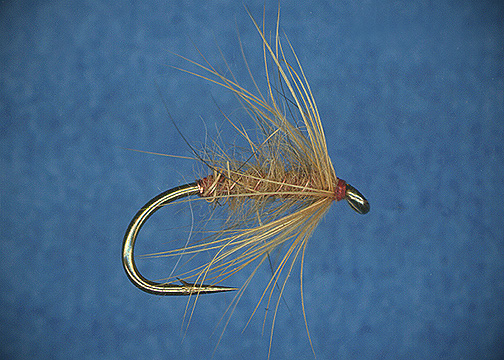 Ginger Spider tied on a Daiichi 1530 There are other great "standard" wet fly hooks like Mustad S80-3906 and Daiichi 1550 Rodger Fogg, English wet-fly fisherman suggested Drennan Specimen style hooks for traditional North Country spiders. Equivilent are the Daicchi 1640 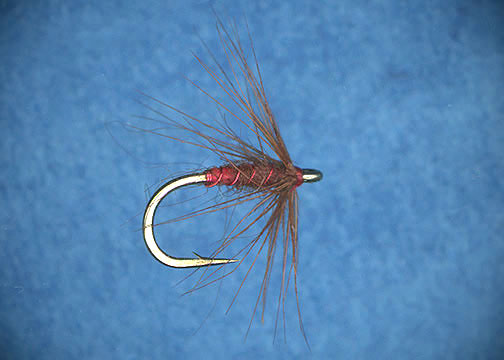 Ruddy Spider Another nice spider hook is Mustad R48 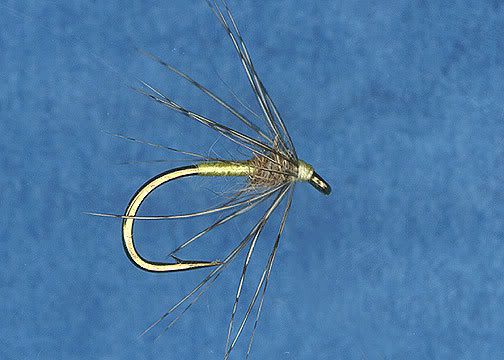 Partrdige and Yellow The Mustad C53S or similar adds a great mayfly or stonefly profile: 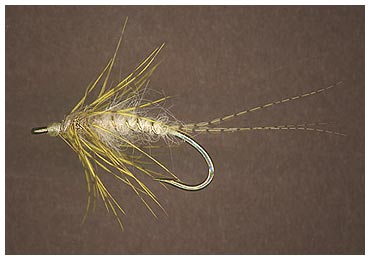 Of course emerger or scud hooks work well 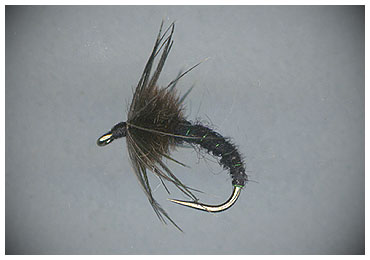 Black Star Emerger This style also makes great wingless wets. Daiichi, Partridge, and Grip hooks from S. Africa make this style with a lot of implied action. This one is a Grip 14723BL, which is barbless, but they make a barbed version as well. 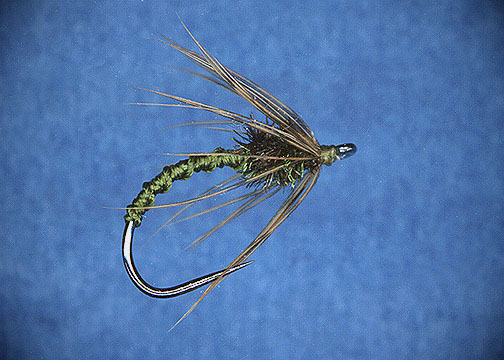 Green Goblin there are special hooks designed especially for Soft-hackles as well and many more that are great for wingless wets including the turned up eye hooks, and don't forget dry fly hooks as well. Do you have a favorite for wets? If so, what are they. Mark | |
| "I have the highest respect for the skilled wet-fly fisherman, as he has mastered an art of very great difficulty." Edward R. Hewitt Flymphs, Soft-hackles and Spiders: http://www.troutnut.com/libstudio/FS&S/index.html | ||
| Oldredbarn | October 31st, 2011, 9:50 pm | |
| Novi, MI Posts: 2608 | Mark, They all look nice, in their way, but I'm fond of the "sproat" style like your Mustad 3399A there for the wets. Spence | |
| "Even when my best efforts fail it's a satisfying challenge, and that, after all, is the essence of fly fishing." -Chauncy Lively "Envy not the man who lives beside the river, but the man the river flows through." Joseph T Heywood | ||
| Falsifly | October 31st, 2011, 10:23 pm | |
| Hayward, WI. Posts: 661 | I, like my friend Hans Weilenmann, believes the hook is the armature upon which our flies are constructed. Well done Mark, and the word “armature” is most fitting. Armature: A framework serving as a supporting core for the material that is used to make a sculpture. | |
| Falsifly When asked what I just caught that monster on I showed him. He put on his magnifiers and said, "I can't believe they can see that." | ||
| CaseyP | October 31st, 2011, 10:26 pm | |
| Arlington, VA/ Mercersburg, PA Posts: 653 | Mark, at last a set of pictures to help this woefully ignorant tyer buy hooks that "look right". what a great service to mankind!! my trip to Somerset will be so much more rewarding, and my wet flies so much more pleasing than before--i owe you one, buddy! at the moment, when i tie wets, i look for something in the hook box that is sort of shortish and wide-ish and kind of heavy or not. | |
| "You can observe a lot by watching." Yogi Berra | ||
| Oldredbarn | October 31st, 2011, 10:34 pm | |
| Novi, MI Posts: 2608 | I agree with you Casey, and I feel that this Mark Libertone character could turn any old "iron" in to a work of art...;) Spence | |
| "Even when my best efforts fail it's a satisfying challenge, and that, after all, is the essence of fly fishing." -Chauncy Lively "Envy not the man who lives beside the river, but the man the river flows through." Joseph T Heywood | ||
| Softhackle | November 1st, 2011, 7:38 am | |
Site Editor Wellsville, NYPosts: 540 | Casey, Hook profile is, IMO, an important part of fly creation. The profile gives the overall impression to the fly, and getting the right profile for insect imitation can lead to better fly design and success. Looking at the flies I've posted, the Mustad C53S profile is okay, but I've switched this hook out for a Daiichi 1260 because of the angle of the barb on the C53S is a little to steep. The 1260 gives a more open, level barb angle for better hooking.  Daiichi 1260 The Daiichi 1760 is similar in profile, but a heavier wire for fishing deeper:  This next one is a Daiichi 1150, which is similar in profile to the Grip 14723BL, but a bit heavier in wire.  You, must think of the job the hook will be doing for you -how it it will be fished and what you want it to look like in the water. As I said above, many tie wingless wets on dry fly hooks to be fished in the surface film, upstream or up and across. The selection of the lighter wire and rounder bend of most dry fly hook are appropriate for this application. I hope I haven't befuddled you more. I can be rather overwhelming. It's just a matter of thinking it through. Spence- I said flies are art in a manner of speaking, but they have a practical purpose as well! Mark | |
| "I have the highest respect for the skilled wet-fly fisherman, as he has mastered an art of very great difficulty." Edward R. Hewitt Flymphs, Soft-hackles and Spiders: http://www.troutnut.com/libstudio/FS&S/index.html | ||
| Sayfu | November 1st, 2011, 9:01 am | |
| Posts: 560 | Here is a negative thought, and an experience I had with a hook design that created a good looking fly...the Tiemco 200R. I used them to tie Kaufman's stimulators that were very popular at the time on the Yakima River in WA., and still are around the country. I was guiding at the time, and client after client would lose fish on that hook. Kaufman's was located near me, and I was a constant customer in their East Side store out of Bellevue/Redmond. John Farrar, a well known guide, was working at the store, and John is still guiding by the way, and that was a good 20 yrs. ago. I mentioned to John my problem, and John said, "Oh, you have to bend out the hook away from the shank. The curvature at the bend is too shallow on that hook model" I don't like to do that for fear of weakening the hook so changed hook models. | |
| Oldredbarn | November 1st, 2011, 10:20 am | |
| Novi, MI Posts: 2608 | Spence- I said flies are art in a manner of speaking, but they have a practical purpose as well! Hey professor! Don't you recognize a compliment when you see one...:)? I'm trying to butter you up for that "A" your going to give me at the end of the semester...;) Spence Sayfu, I had an odd experience this last spring with hook design. I had purchased some Targus knock-off hooks at a fly tying show that had a wide gape. They were more of a bass style fly...The fly looked wonderful and a nice little trout thought so too and smacked it...Due to the wide gape the thankfully de-barbed hook point actually came out in the fishes eye socket just below the eyeball, just missing it's eye...I was in a bit of a panic since I didn't want to harm the little fella...I gently removed it and the fish seemed no worse for wear...I'm not too sure though that I need to be using those particular hooks on trout...Maybe a different design may help, but I haven't thought it through. In terms of bending hooks...A little heat helps...The original Klinkhammer was tied on a hook that needed to be bent (See Oliver Edward's "Master Class")...There has since been a hook designed for that pattern...I think that a caddis pattern by Gary LaFontaine was bent this way as well at first...It may have been his dry fly pattern that was tied with the hook riding upside-down, "Skittering Caddis with the hook inverted (?) | |
| "Even when my best efforts fail it's a satisfying challenge, and that, after all, is the essence of fly fishing." -Chauncy Lively "Envy not the man who lives beside the river, but the man the river flows through." Joseph T Heywood | ||
| Sayfu | November 1st, 2011, 10:43 am | |
| Posts: 560 | When you bend the barb out away from the line of the shank it can result in more positive hookups, but the fly can also spin. You have to careful how far you bend it away from the shank, and also not weaken the hook. I'm always reluctant to bend any portion of a hook as a way of creating a fly design. I see hooks bent to create the larger stonefly nymphs, and ways to ride the hook in the water. I just never feel good about doing it for how the hook then "sets" on a fish take if nothing else. | |
| CaseyP | November 1st, 2011, 2:41 pm | |
| Arlington, VA/ Mercersburg, PA Posts: 653 | and kind of heavy or not. well, it all makes a lot of sense, Mark. your description is a little more helpful than mine! the Mustad looks a little bit "closed" to me, so it wouldn't be my first choice. had a maddening moment in a charity tournament a couple weeks ago: my partner had tied a "woven nymph" on something like that Mustad, and i put it through a nice little slot. though 5 fish struck hard, only two got set, and none came to net. not my best sporting moment... so we'll look for another nice heavy, but more open, curved emerger-type hook and try that fly again. | |
| "You can observe a lot by watching." Yogi Berra | ||
| Entoman | February 16th, 2012, 2:46 pm | |
| Northern CA & ID Posts: 2604 | Jere -...the Tiemco 200R. I used them to tie Kaufman's stimulators that were very popular at the time on the Yakima River in WA., and still are around the country. I was guiding at the time, and client after client would lose fish on that hook. Wow, is that the truth! I hate the damn things. When they first came out I experimented with them, tying some sexy looking drab wingless wets for Summer Run's. Got the same results you did!.. The problem is that a Stimulator somehow just doesn't look right on a straight shanked down eye hook. Fortunately, many manufacturers are now making 2x long curved dry fly hooks with a ring eye and a more open bend. They have that same unique profile in the finished fly, but seem to hook up just fine with the added bonus of floating much better. Spence - The problem with heating hooks is that it doesn't take much of it to ruin the finish. I remember a big stonefly nymph tied on a "modified" hook that broke in the middle just below the wingcase! Though the bend and point looked fine the shank had invisibly rusted where I'd heated it, to the point of rot. Luckily it happened getting it free from a snag not losing a fish, but lesson learned. Besides, the temper is still messed up in after-market heat applications anyway. The proper process is to bend the un-tempered wire stock to the proper shape first (including formation of the eye, point and barb), temper it precisely, and then apply the finish. While after-market heat makes it easier to bend, I believe the molecular structure remains compromised. The original temper is damaged, not to mention the protective aspect of the finish. Mark - Since you asked, I like the TMC 3769 for standard wets. For North Country's, I'm really happy with TMC 9300's. It has nice lines (I really like the ever-so-slightly dropped point), especially with the shorter bodies I prefer, and it fishes really well with the dead drift presentations I most often use with this style. | |
| "It's not that I find fishing so important, it's just that I find all other endeavors of Man equally unimportant... And not nearly as much fun!" Robert Traver, Anatomy of a Fisherman | ||
Quick Reply
You have to be logged in to post on the forum. It's this easy:
Related Discussions
| Title | Replies | Last Reply |
| Re: Tying Demo In Fly Tying by Softhackle | 3 | Jan 6, 2008 by Softhackle |
| Re: skinny hooks, fat hooks In Fly Tying by CaseyP | 4 | Mar 3, 2014 by Catskilljon |
| Re: Hook Wire In Fly Tying by Entoman | 15 | Aug 21, 2011 by Softhackle |
| Re: Tiemco vs. Mustad In Fly Tying by WestCO | 24 | Oct 2, 2011 by Sayfu |
| Re: Tiemco hooks In Fly Tying by Flytyerinpa | 3 | Oct 7, 2021 by Wbranch |
| Re: Nymph and Dry Fly Rigs In General Discussion by Hellgramite | 4 | Jan 6, 2010 by Cdcaddis18 |
| Re: Hooks In Fly Tying by Strmanglr | 35 | Feb 14, 2012 by Entoman |
| Re: Emerger hooks In Fly Tying by Martinlf | 31 | Mar 8, 2010 by Gutcutter |
| Re: Borcher's Drake In Female Leptophlebia Mayfly Dun by Oldredbarn | 3 | May 13, 2010 by TNEAL |
| Re: Fishing emergers In General Discussion by Adirman | 1 | Aug 29, 2018 by Martinlf |
Troutnut.com is copyright © 2004-2024 Jason
Neuswanger (email Jason). See my FAQ for information about use of my images.
 privacy policy
privacy policy





